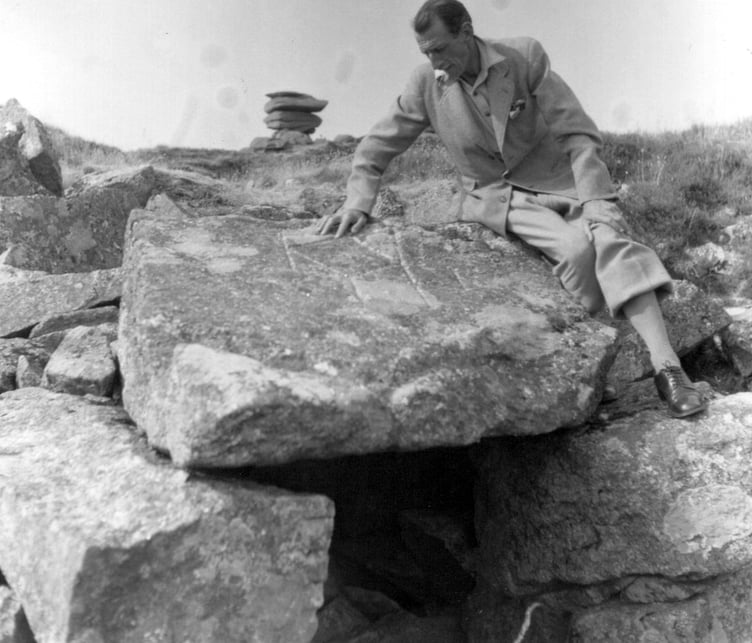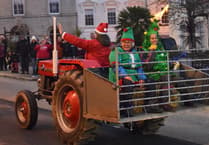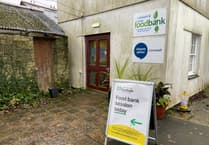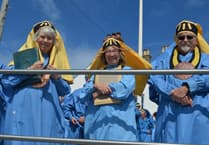By Brian Oldham
‘Bill’ Paynter was born, grew up and married in Callington. He arrived in Liskeard in early 1941 with Doris, his wife of eight years, and Anne, their six year old daughter. They lived at 18 Castle Street, where John Wesley’s followers had established their first meeting house in Liskeard over 180 years before.
Paynter became secretary, performer and playwright for the Liskeard Drama Group, he was an active member of Liskeard Old Cornwall Society, being its President in 1971 and 1972, and Archivist for the Borough of Liskeard in the 1950s, and their Deputy Mayor in the 1960s. But his overwhelming passion was to research Cornish history, in particular its folklore. Paynter retired from full-time employment in about 1958 and for a short time managed his son-in-law’s zoo in East Looe, probably where the Monkey Sanctuary is today. After this he opened the ‘Cornish Museum’ in Lower Street, East Looe, where he displayed the artefacts, images and research material gathered from his many years of study, and collecting oral histories across the County. The building is now a private residence known as ‘Old Museum Cottage’.
As well as regular broadcasts on BBC radio and television, Paynter contributed regularly to the Cornish Times. In December 1932 he wrote about two people in Liskeard who believed themselves to have been ill-wished after becoming infested with body lice, ‘one man went to a wise woman, and she told him the only thing to do was to go to the highest field in the parish at sunrise, take off his shirt, flick it three times and shout out some words she had prescribed’.
On February 19, 1937, the Daily Mail printed an article by Paynter entitled ‘Phantom Dog Reappears’. There had been numerous sightings of ‘a large black dog on the road between Linkinhorne and Rilla Mill’ in the 19th and early 20th centuries. Some reports mentioned it had ‘eyes like saucers’ or having no head at all. All reports claimed the dog was of ‘huge proportions’ and that ‘there is no sound of its approach and it vanishes as silently and swiftly as it appears’. Paynter interviewed several witnesses and spent a night there himself, but failed to see the dog. It was said by some to be ‘a call from the dead by a tormented soul’, but the sightings ceased when ‘a grey farm dog with a long chain which has been straying in the parish’ was eventually captured.
Paynter was told of many Cornish remedies for thrush in the mouth and throat. In East Cornwall a popular cure for thrush was to ‘procure six threads of cotton, pass them separately through a cat’s mouth, and then through the mouth of the sufferer. After doing so, throw the threads into a stream, and as the current bears them away, so the complaint will disappear.’
In the 1920s Paynter collected many superstitions from the district concerning babies. One was to never wash the right hand of a baby until it was a year old, to clean it would deprive the poor child of riches. Another was to never cut a baby’s nails for the first months, they must be bitten by the teeth, or the baby would grow up to be a thief and a rogue. And a necklet of blue beads worn round the neck protected the child against bronchitis, whereas red beads averted sore throats.
From his ‘Cornish Museum’ in East Looe Paynter sold his own talisman, or lucky charm, called the ‘Hap Da’, Cornish for good luck. It had upon it images of an engine house, a Cornish cross, a chough, a quoit and a pilchard, together surrounding the Five Pointed Star and the Celtic Mystical Sign. Thousands were sold at three shillings each after it was featured in the National Press, Radio and Television in the 1960s. Paynter offered ‘this Talisman with every confidence in the authenticity of the symbols depicted and their alleged power to influence the Health and Fortune of the Wearer’.





Comments
This article has no comments yet. Be the first to leave a comment.